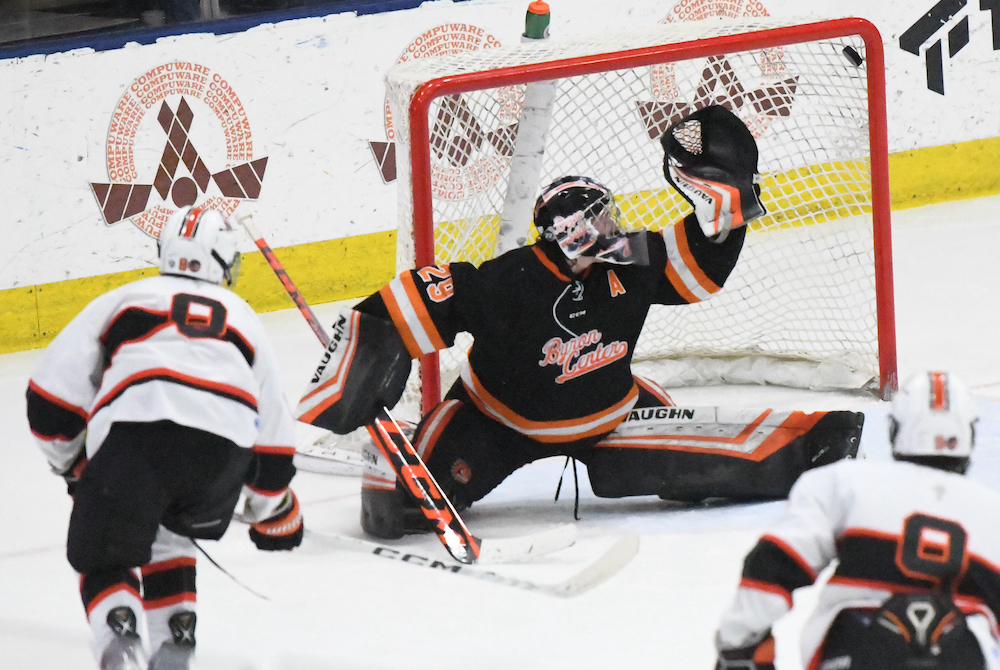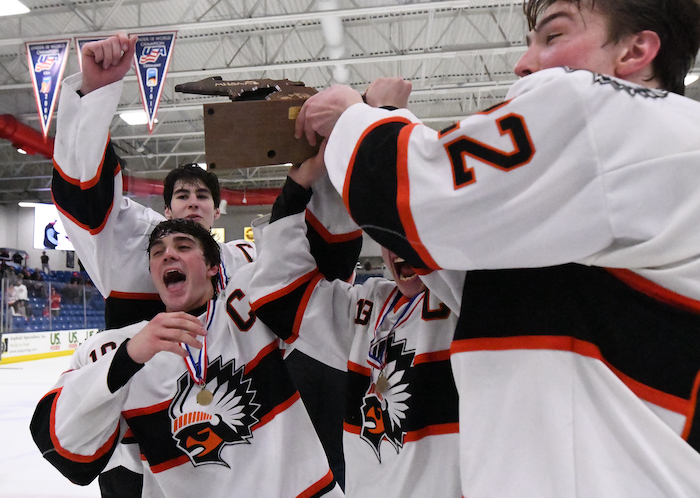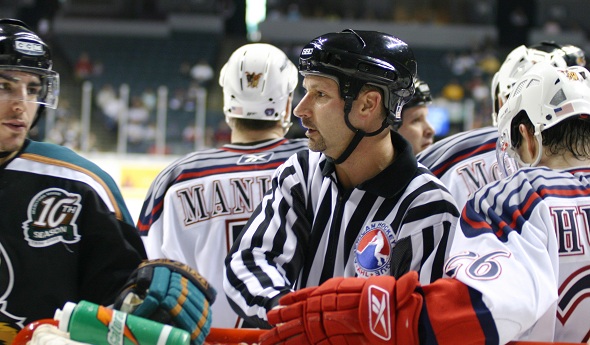
Senior Standout, Surging Sophomore Bring Brother Rice Back in D2 Finale
March 11, 2023
PLYMOUTH — Kenny Chaput, hockey coach at Bloomfield Hills Brother Rice, paused when trying to describe his relationship with sophomore forward Roman Villaire.
“Him and I have had about a year and a half of … fun,” Chaput said.
Care to elaborate?
“We’ve had our ups and downs as far as getting on him,” Chaput said. “He’s literally been all over our lineup from the first line to the fourth line and threats of playing JV hockey and everything else around the way. Again, it’s because the talent’s there.”
The talent Chaput believed Villaire possesses blossomed in the playoffs and burst through at precisely the right moment for the Warriors in the MHSAA Division 2 championship game Saturday at USA Hockey Arena.
Villaire scored what proved to be the winning goal in a 4-2 victory over top-ranked Byron Center with a great individual play.
He picked up the puck at the Rice blue line, skated one-on-one against a defender, made a quick move to open up a shooting lane and fired the puck into the upper right corner of the net with 4:42 left in the game to break a 2-2 tie.
“I just saw (the defenseman) go down to one knee, saw I had a shot, took it to the middle and just put it top right,” Villaire said.
Coming into the playoffs, Villaire had enjoyed a decent regular season, but wasn’t one of the Warriors’ impact players. He had three goals and eight assists in 26 regular-season games, but scored four goals with five assists in five postseason contests.
 “That’s not a grinder goal right there,” Chaput said. “That’s a skilled kid who can really bring the offense. He’s had to learn the other things around the game — playing harder, playing more defensive, and he’s done it. It’s a great thing to see how the game really ended with that goal, because he came a long way to get there.”
“That’s not a grinder goal right there,” Chaput said. “That’s a skilled kid who can really bring the offense. He’s had to learn the other things around the game — playing harder, playing more defensive, and he’s done it. It’s a great thing to see how the game really ended with that goal, because he came a long way to get there.”
While Villaire became an unlikely hero during the Warriors’ run to their seventh MHSAA championship, star forward Peter Rosa performed like the elite player he is.
Byron Center took a 2-0 lead into the third period on first-period goals by Logan Nickolaus and Cade Pratt before Rosa scored three of the Warriors’ four unanswered goals.
He began the comeback with a shorthanded breakaway goal at 1:37 of the third and tied the game with a shot off a faceoff win by Jack Cassidy at 10:42.
After Villaire gave Rice the lead, Rosa completed his hat trick and secured the championship by scoring into an empty net with 20.7 seconds remaining.
“We won sophomore year,” said Rosa, who turned down an offer to play juniors in the North American Hockey League to finish his career at Rice. “A couple of us like (Andrew) Marone and Cassidy were together for that championship. We lost in the semis last year. Marone was hurt, so that didn’t help us out.
“In the locker room, we have a back wall that’s full of banners. There’s one bottom corner that’s empty. Every day we came to practice, we said, ‘That’s our spot.’ It’s great to finish on top.”
For Byron Center, it was the second gut-wrenching loss to Rice in the championship game over the last three seasons. The Bulldogs lost 2-1 two years ago when Rice’s Alex Hamady scored with 6.7 seconds to play.
In those two seasons, Byron Center took a combined record of 46-1 into the championship games. The Bulldogs were 28-1 going into Saturday’s matchup.
“It’s a lot of heart and hard work,” said senior Byron Center goalie Carson MacKenzie, the starter in both championship games. “Coming to the rink every day, seeing these guys I’ll never forget. I just hope the future years the underclassmen are going to see how hard we work. I’m so proud of everyone, just stuff we’ve done. I’ve never lost a Regional championship. It’s crazy accomplishments I can be so thankful for. I’m happy to be here right now with my teammates.”
First-year Byron Center coach Jordan Steger, an assistant coach the previous three seasons, told his players the bonds they’ve formed are more valuable than the outcome of one hockey game.
“From day one, it’s been a family,” Steger said. “Like I just reiterated to the guys in the locker room, that doesn’t stop because the season’s over. There were 26 of us this year, three coaches and 23 boys, and that family doesn’t stop because the season’s over. We’ll always be there for each other, not just at the rink, but like I told these young men, a lot of them will be in each other’s weddings and get to know each other’s kids. That means so, so, so, so much more than even a state championship.
“Getting to know these young men has been far more of a gift than a state championship.”
PHOTOS (Top) Bloomfield Hills Brother Rice’s Roman Villaire (8) finds the top corner of the net for what became the winning goal in Saturday’s Division 2 Final. (Middle) The Warriors celebrate their second championship in three seasons.

Garofalo: On-Ice Teacher and Recruiter
By
Rob Kaminski
MHSAA benchmarks editor
December 28, 2012
Something caught his eye as Allen Park’s Jim Garofalo circled the Olympic hockey rink in Salt Lake City to familiarize himself with the surroundings prior to the start of play at the 2002 Games.
“When the dimensions of a rink are laid out, everything is measured from the exact center of the ice outward,” Garofalo explains. “Usually there’s a washer or something small under the surface at center ice. All measurements are taken from there.
“Well, in Salt Lake City that year, a Canadian company was hired to prepare the sheets of ice, and they used a Loonie (common term for a Canadian $1 coin) to mark center ice. That year, the Canadians beat the United States in the gold medal game and won the Olympics on U.S. soil. I later visited the Hockey Hall of Fame in Toronto, and that Loonie is there.”
As Garofalo was getting acquainted with Canadian currency, an invitation in his mailbox back home went unanswered. At the time, MHSAA Tournament invitations were still sent by mail, so Garofalo was unaware the Association was awaiting his RSVP to accept his first Finals assignment.
“I was in Salt Lake City and had no idea. Now, of course, everything is online and by email, but that just shows how rapidly technology has progressed in the last 10 years,” Garofalo said. “So, (fellow official) Dan DiCristofaro calls and says something like, ‘Hey, do you want your state final?’ It was pretty funny; the running joke afterward was that you’ve gotta work the Olympics to get a shot at the state finals.”
Of course, that’s not the case. And, if Garofalo had it his way, all hockey officials who worked hard, persevered, paid their dues and set that as a goal would get a shot at the MHSAA Finals.
A 25-year registered MHSAA official who at one time juggled rules books for eight different hockey leagues and has worked four World Championships in addition to the Olympics, Garofalo now works only high school hockey.
“From a selfish standpoint, I suppose, I like a season that has a definite start and end to it,” says the New Boston Middle School social studies teacher, whose resume’ at one point looked like an endless Scrabble hand that included abbreviations for USA, USA Junior, Ontario, East Coast, International, International Independent and Central Collegiate hockey leagues in addition to the MHSAA.
“Being a teacher, there’s so much about the high school game that fits into education,” said Garofalo, now in his 10th year with the New Boston Huron District. “There’s so much to learn, and to help people learn at this level, from a playing and officiating standpoint.
“The people who officiate high school hockey are dedicated to improving, and as a veteran there’s an opportunity to help them learn and advance,” he says. “And, the coaches deserve kudos too. They are usually more professional and ask questions more properly than at other amateur levels. The reason is a direct result of them being accountable. They’ve got to answer to their principal or athletic director. Who are the junior and community league coaches accountable to? No one.”
 And, there’s another allure to the school game compared to which other levels pale.
And, there’s another allure to the school game compared to which other levels pale.
“The atmosphere of high school hockey is better than any other amateur level,” Garofalo says. “You go do a game at Trenton, and there’s a band. How many hockey games do you go to where there’s a band? Detroit Catholic Central and Birmingham Brother Rice have their cheering sections. It’s just a great atmosphere.”
It’s a scene that would surely help maintain the roster of younger, driven hockey officials. The trick is getting them there, according to Garofalo, one of the MHSAA’s biggest proponents for advancement and recruitment of officials.
Part of the issue is the oversaturation of games that fill Mite, Midget and other amateur schedules. Those who simply want a paycheck are never at a loss for work as long as they know how to skate.
“Hockey is unique because high school hockey is in progress at the same time as USA Hockey. An official can get twice the pay at a Bantam/Midget doubleheader than they can for one high school game,” Garofalo said. “The trouble is, who is instructing them? Who’s helping them to develop?”
To that end, Garofalo, DiCristofaro and the rest of the Northeast Hockey Referees Association established a $500 college scholarship. The recipient must be a high school hockey player who is officiating games in USA Hockey. Once they graduate from high school, many join the Association to work high school hockey.
Garofalo also offers other recruiting initiatives. In the Michigan Interscholastic Hockey League most schools play JV/Varsity doubleheaders, where the officials often let a linesman work a game at referee, while the experienced referee observes.
“At events like the Trenton Showcase, if we divide the fees differently we could get more officials involved,” he suggests. “We can do four-person crews to get our good young people some varsity experience as linesmen, and move some of our experienced linesmen to referee on the same crew with some of the top referees.”
It’s the kind of continual teaching that perpetuates the quality of officiating, and it takes time. The goal is to have the officials ready to perform when they hit the ice.
“If I put you out there to referee or pull lines, I set you up to succeed,” Garofalo says. “If I put people in too soon, I’ve set them up to fail, which leads to them leaving the game, and I haven’t done my job.”
The expectations and production of teacher and student must mesh for the system to work as intended. It requires patience as officials strive to climb the ladder, a bit of a lost art in today’s society.
“The culture of newer officials today is different. It’s a culture of immediate gratification,” says Garofalo. “Very few want to hang around eight to 10 years as a linesman before they referee, or move up. There are some very good officials who leave each year, because they haven’t become a referee, or haven’t got a tournament assignment.”
At the MHSAA Finals, Garofalo and DiCristofaro assist Jim Gagleard and the Livonia Ice Hockey Officials in heading up the off-ice officials. The inclusion and experience of such officials serves as a motivational tool which leads to improvement and retention. He also believes a four-person system in the MHSAA tournament would not only afford more qualified officials an opportunity for postseason assignments, but also provide better ice coverage as the sport’s speed has increased dramatically.
Not everyone can reach the summit, no matter the level. Even Garofalo himself, who once entertained dreams of skating in the NHL.
“The NHL looked at me a bit, but when I was at that age, it seemed all of the other linesmen were in their prime,” he said. “It is what it is.”
But, for a guy who began officiating at age 15 just to help pay for his hockey equipment, things have turned out quite well. In addition to the 2002 Olympics, Garofalo worked the Women’s World Championships in 1990, and the Men’s Worlds in Switzerland (1998), Norway (1999) and Germany (2001), working the Gold Medal game in 1998 and 1999. He’s been a fixture at the MHSAA tournament during the last dozen years.
“My wife, Mary Beth, says, ‘Wherever you go, you know someone.’ I owe that to officiating; the places I’ve gone and the people I’ve met,” Garofalo said. “It’s taken me all over the country instructing, and even overseas for some assignments. I can’t help but know people. It’s a people business.”
It might seem odd for Garofalo to even utter those words, describing the people-person this once shy kid has become. That’s one of the many rewards officiating delivers which is more valuable than any top-level assignment or game fee.
“I was quiet when I was younger. Well, when a coach is going crazy and yelling, you’ve got to speak for yourself. You learn conflict resolution,” Garofalo says, continuing as if he wrote the book on it. “‘Coach, get off the bench, quit screaming, and I’ll explain what I saw and why I called it the way I did. Then , if you have a question, I’ll answer it.’ You learn to communicate with people who don’t always agree with you.”
Then, there are the memories. Memories won’t buy a thing, but they go a long way in making 25 years on the ice, thousands of miles on the road, and countless hours away from home worth a million bucks.
“I worked 25 years for the IHL and AHL, and two years ago at the end of the regular season I was doing a Grand Rapids Griffins game. During the game, I told Brad May, ‘I’m done,’” Garofalo recalls, confiding in the gritty enforcer and one-time Stanley Cup champion who had more than 1,000 NHL games under his pads.
“At the end of the game, every guy and coach skated to me and shook my hand. Then Brad May says, ‘I heard you once worked the Olympics. It was an honor to be on the ice with you,’” Garofalo reveals, shaking his head. “Brad May said that to me.”
PHOTO: Jim Garofalo (center) officiate an NHL game. The Allen Park resident also has worked the Olympics.
NOTE: This is the sixth installment in the series "Making – and Answering – the Call" detailing the careers and service of MHSAA officials. Click the links below to view the others.

